|
Week 1: October 31 - November 6, 2009 |
Welcome
to the McGill Bird Observatory weekly report.
Click here for a complete listing of our archives.
Comments or
questions are welcome at "mbo AT migrationresearch.org".
|
PICTURE
OF THE WEEK: |
|
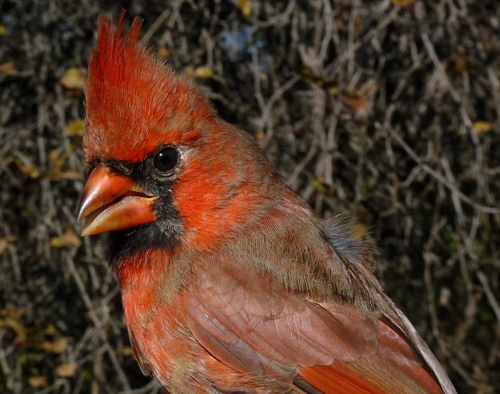
After being rather quiet for the past couple of months, Northern Cardinals were particularly
active at MBO this week, perhaps reflecting the dispersal of this year's young, such as
the hatch-year male above (note the contrast in the wing between the new bright red
primaries
and the retained faded brown juvenile feathers to the right)
(Photo by Marcel Gahbauer)

|
MBO
gratefully acknowledges the in-kind support provided for winter 2009-2010 by CCFA (Centre de Conservation de la Faune Ailée) in Montreal, in the form of bird seed to keep the MBO feeders stocked throughout the season.
|
|
|
|
THIS WEEK |
THIS FALL |
2009 TOTAL |
SITE TOTAL |
|
# birds (and species) banded |
28 (8) |
28 (8) |
4422 (84) |
23343 (105) |
|
# birds (and species) repeat |
15 (5) |
15 (5) |
900 (50) |
4247 (66) |
|
# birds (and species) return |
1 (1) |
1 (1) |
161 (32) |
615 (37) |
|
# species observed |
39 |
39 |
166 |
199 |
|
# net hours |
157.0 |
157.0 |
9352.9 |
39818.2 |
|
# birds banded / 100 net hours |
17.8 |
17.8 |
47.2 |
58.6 |
|
|
Note: table does not include nocturnal banding (owls) |
|
Banders-in-charge: Simon Duval, Marcel Gahbauer, Gay Gruner
Assistants: Jenia Faibusovitch, Barbara Frei, Bana Hamze, Marie-Anne Hudson, Kristen Keyes, Chris Murphy, Rodger Titman
Notes: Last week our official fall migration monitoring program ended, but we had so many birds still moving through over the final couple of days that we decided to continue with the full protocol for a while longer to see when migration would taper off. Well, as it turned out, we didn't have to wait long to answer that question! On Saturday morning the site was still teeming with birds, with American Robins, Slate-coloured Juncos, American Tree Sparrows, and Fox Sparrows especially numerous. However, it was windy and rainy, so no banding was possible. That afternoon the winds gusted up to 80 km/h, and when the skies cleared at night, it seems like most birds decided to clear out, as Sunday was remarkably quiet in contrast to what we had become accustomed to. Monday was more silent yet, with only 7 birds banded in a full morning of operation, so we decided to shut down at that point and continued with census and supplemental observations for the rest of the week, and they confirmed that numbers remained low.
Despite the much lower numbers, we still had some interesting moments this week. On Sunday we banded another Northern Shrike, quite different in appearance from the one we had just a couple of days before (see the photo below). The Townsend's Solitaire first discovered on the last day of the fall season has stayed around all week, though it is elusive, and has only been spotted every few days. The local Pileated Woodpeckers have been particularly active this week, after being unusually scarce this fall. And thanks to a generous donation of seeds from the Centre de Conservation de la Faune Ailée, we have the MBO feeders well stocked, and they are already attracting a good number of sparrows, finches, and other birds.
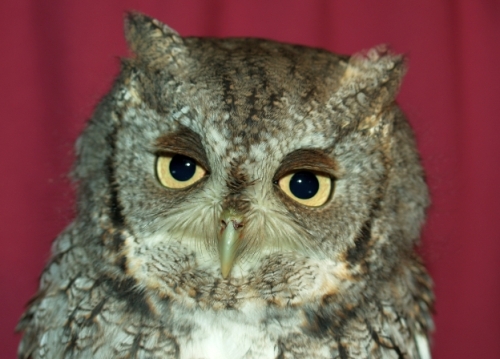
As the owl banding season nears a close, the nights are getting colder, but surprises like this make the effort rewarding. This Eastern Screech-Owl banded on Friday night was only the second in MBO's history, although we have certainly heard them on a number of other occasions.
(Photo by Simon Duval)
|
Owling continued several nights this week, and again we have a few interesting results to report. The Eastern Screech-Owl above was a nice way to finish off the week, but prior to it we had banded another 6 Northern Saw-whet Owls. Also this week we recaptured one saw-whet that we banded over two weeks earlier, suggesting that perhaps it is considering remaining in the area over winter. But the most exciting development of the week was on Sunday night, when one of the owls we had banded earlier this season was recaptured over 700 km to the south at Lamb's Knoll, Virginia - a substantial distance to move in less than three weeks!
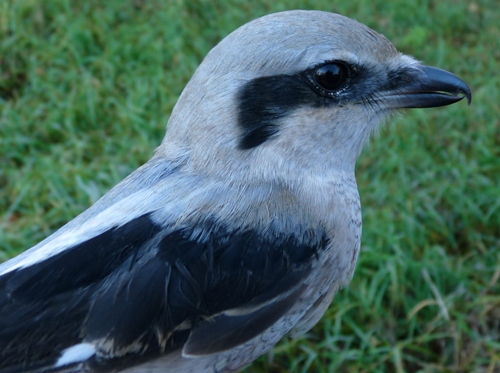
On Sunday we banded our second Northern Shrike in three days. Compared to the very brown individual at the end of last week, this one is quite gray - but there remains a distinct moult limit on the wing between new black feathers and unreplaced duller juvenile feathers, so this too is a hatch-year bird.
(Photo by Marcel Gahbauer)
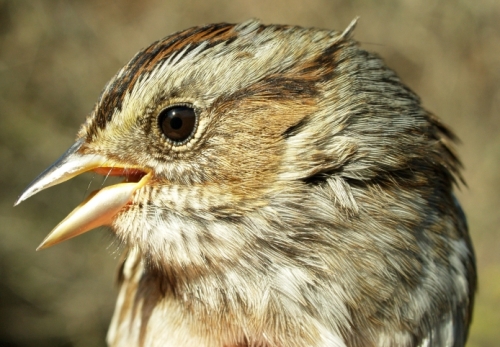
Swamp Sparrow isn't usually a species we think of as a "winter bird" at MBO, and the fact we caught one this week probably just means it is a late-lingering fall migrant that happened to stay around a bit past the end of what we have officially defined as being the fall season.
(Photo by Simon Duval)
|
All of a sudden, our top ten list of birds banded this week is back to being a short and meager compilation, with not even enough species to fill the whole table. Last week's top five remained on top this week, albeit a bit jumbled up ... but given that fifth place was achieved with only two individuals this week, it's not terribly meaningful. Certainly times like this are about the only way in which species like Northern Shrike and Northern Cardinal will ever get featured in this part of the program reports!
This week’s top 10 [last week's rank in brackets]
# individuals banded |
mean # individuals observed daily |
1. Slate-coloured Junco (10) [1] |
1. Red-winged Blackbird (195) [1] |
2. Black-capped Chickadee (6) [3] |
2. American Robin (68) [2] |
3. Fox Sparrow (4) [5] |
3. Slate-coloured Junco (43) [5] |
4. American Tree Sparrow (3) [2] |
3. Canada Goose (43) [4] |
5. White-throated Sparrow (2) [4] |
5. American Crow (30) [3] |
6. Northern Shrike (1) [-] |
6. American Goldfinch (17) [-] |
6. American Robin (1) [9] |
7. Black-capped Chickadee (16) [6] |
6. Northern Cardinal (1) [-] |
8. Mallard (9) [7] |
| |
9. White-throated Sparrow (8) [8] |
| |
10. European Starling (8) [10] |
|
Red-winged Blackbirds and American Robins remained the most numerous birds observed at MBO this week, but their numbers were down considerably, and the same holds true for the rest of the top ten. The only addition to the list this week was American Goldfinch, largely thanks to a flock of 48 observed on Thursday morning, perhaps already attracted by the feeders. In all, the 39 species observed this week was a record high for the first week of November, and more in fact than we've sometimes had in the whole month. No doubt that was influenced to some extent by the extra effort on site this week, and we expect the list to grow much more slowly over the rest of the winter. For the remainder of the season we will return to posting one update per month, then will resume with weekly reports when the spring season begins at the end of March.
|
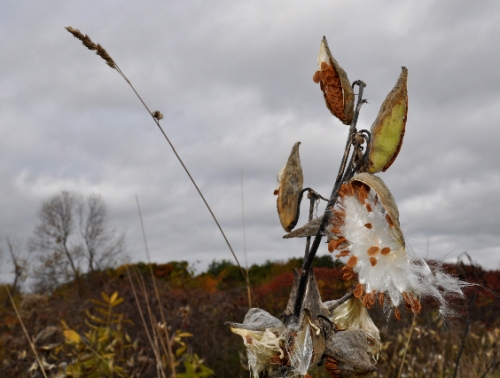
All around the site it looked and felt like late fall this week, with milkweed pods bursting against a largely brown background, and leaves tinged with frost accumulating on our boardwalks along the census trail.
(Photos by Barbara Frei)
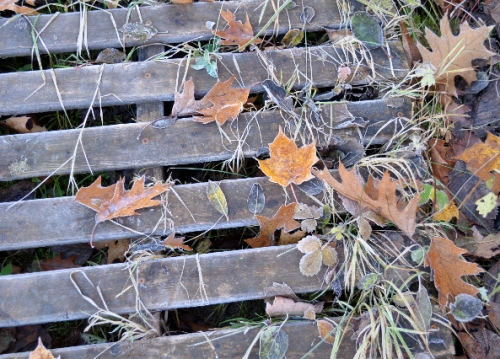
|







